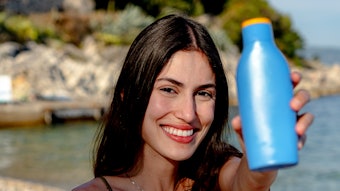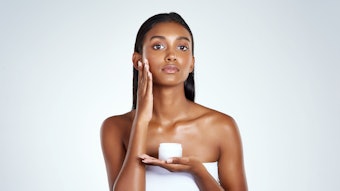According to market research, baby boomers’ unprecedented purchasing power, coupled with a youth-dominated cultural shift and modern technological advancements, have fueled a rapidly growing US antiaging industry that exceeded US$45.5 billion in 2004, $7.7 billion of which was spent on appearance products alone.1 Another report anticipated sales of cosmeceuticals in the United States to grow to more than $16 billion by 2010.
Log in to view the full article
According to market research, baby boomers’ unprecedented purchasing power, coupled with a youth-dominated cultural shift and modern technological advancements, have fueled a rapidly growing US antiaging industry that exceeded US$45.5 billion in 2004, $7.7 billion of which was spent on appearance products alone.1 Another report anticipated sales of cosmeceuticals in the United States to grow to more than $16 billion by 2010.
Oftentimes, cosmeceutical products incorporate such age-reversing and appearance-rejuvenating claims as: “aging is reversible and optional”; “regenerates damaged skin”; “penetrates deeply into the layers of the skin”; “erases wrinkles and boosts collagen synthesis within 10 days”; “stimulates cellular metabolism within days”; and so on. An Australian survey conducted by CoreData and www.news.com.au reported that 55% of the respondents did not trust the accuracy of the scientific claims made by cosmetic companies, and many were cynical about those claims.2
It is therefore unclear whether cosmeceutical products should be considered a new regulatory subcategory of cosmetics, or if they should be regarded as medicinal products. So what are the rules regulating product claims for this category, and what are the substantiation standards?
Legal Distinction Between Drugs and Cosmetics in the United States
In the United States, regulatory requirements for cosmetics and drugs are established by the Federal Food, Drug and Cosmetic Act (FD&C Act) of 1938 and enforced by the US Food and Drug Administration (FDA).
The act defines cosmetics as:
“Articles intended to be rubbed, poured, sprinkled or sprayed on, introduced into, or otherwise applied to the human body … for cleansing, beautifying, promoting attractiveness or altering the appearance.”3
Drugs are defined by this act as:
“(A) Articles intended for use in the diagnosis, cure, mitigation, treatment or prevention of disease …; and
(B) Articles (other than food) intended to affect the structure or any function of the body of man or other animals.”4
Currently, products are classified by this legislation based on their intended use. A product’s intended use may be established through its direct advertising or product claims. However, the FDA advises that consumer perception and expectation of the product also constitute the basis for determining the intended use, be it through direct advertisement or indirectly implied promotional messages.5, 6
The FDA sets specific requirements governing cosmetic product labeling, including details such as the product identity display, placement of the name and business location, appropriate ingredient listing, accurate statement of the net quantity of contents, appropriate directions for safe use and appropriate warning statements when deemed necessary. Labeling is defined as including all written, printed or graphic material that appears on the products, containers, packaging inserts and any material accompanying the product. Therefore, any promotional material or statement, including those that appear on the Internet, in product catalogs and in flyers, are considered cosmetic product labeling. These requirements are regulated under two main regulations: the FD&C Act, and the Fair Packaging and Labeling Act (FPLA).
The primary enforcement focus of the FDA on cosmetic products is in regards to misbranding. To qualify as a cosmetic product, the labeling must not imply any physiological effect, must not suggest an impact on structure or function, must not contain ingredients that are commonly regarded as drugs, and must not contain unapproved color additives. If an ingredient is known by the public to have certain therapeutic effects, its use in a cosmetic product without drug claims would in fact violate the FDA misbranding rule. For instance, incorporating acetaminophena into a cosmetic product would instantly classify it as a drug by FDA standards, even if no drug claims are made. Therefore, incorporating drug claims on a cosmetic label deems the product to be misbranded, leading to FDA enforcement action.
In general, a cosmetic product is not allowed to contain ingredients that are commonly regarded as drugs, such as active ingredients recognized for therapeutic benefits. In addition, International Nomenclature of Cosmetic Ingredients (INCI) names should be listed on cosmetic labels instead of the chemicals names associated with therapeutic benefits.
For example, alpha-tocopherol should not be listed as vitamin E in the declaration of ingredients because listing it as such would imply a therapeutic effect. Other examples of ingredients well-known for therapeutic effects include hormones and hydrocortisone.
The Global Situation: Cosmetics vs. Drugs
The definition of a therapeutic drug is quite similar around the world. Most countries agree that a drug is intended for the diagnosis, cure, mitigation, treatment or prevention of diseases via some means of physiological action. When it comes to cosmetics, however, differences exist in major world markets including Australia, the United States, Europe, Canada and Japan.
Australia: In Australia, a cosmetic is defined by the Therapeutic Goods Association (TGA) as:
A substance or preparation intended for placement in contact with any external part of the human body, including the mucous membrane of the oral cavity, and the teeth, with a view to altering the odors of the body; or changing its appearance; or cleansing it; or maintaining it in good condition; or perfuming it; or protecting it.
Similar to the classification standard practiced in the United States, a cosmetic product will be considered therapeutic if it is intended to treat, alleviate or prevent disease; if it claims to affect the structure or function of the human body or have therapeutic effects; or if it contains ingredients possessing therapeutic effects.7 The two major factors used to differentiate cosmetics from therapeutic products are the composition and the proposed use and claims. According to the third edition of Guidelines for Cosmetic Claims by the TGA, cosmetics may not make therapeutic claims unless they are listed in the Australian Register of Therapeutic Goods.8
Sunscreen products in Australia must comply with a different set of mandatory product labeling requirements. Sunscreens are divided into two subcategories—primary and secondary. Although both are regulated by the TGA Department of Health and Aging as therapeutic goods under the Therapeutic Goods Act, their category determines the appropriate labeling requirements. In general, if the main purpose of the product is to protect the skin from UV radiation, then it is usually considered a primary sunscreen. If the product serves a major cosmetic function, such as a color cosmetic or a moisturizer, but contains additional UV protection claims, then it is considered a secondary sunscreen. Primary sunscreens must have the SPF listed clearly on the main label, whereas the SPF in a secondary sunscreen must appear on the package but not necessarily on the main label.
Canada: The Canadian Food and Drugs Act defines a cosmetic as: Any substance or mixture of substances manufactured, sold or represented for use in cleansing, improving or altering the complexion, skin, hair or teeth; and includes deodorants and perfumes.
Similar to the FDA, Health Canada further stipulates that claims of physiological effect are not allowed in cosmetics. A cosmetic product making a therapeutic claim, for example to “prevent or treat disease,” would be classified as a drug under the Food and Drugs Act and therefore a drug identification number (DIN) would be required.9
Personal care products sold in Canada may be regulated under one of the three regulatory schemes: natural health product (NHP) regulations, food and drug regulations, or cosmetic regulations. The determining factors are the ingredients used, the intended uses and product claims. Health Canada estimated that most personal care products sold in Canada are cosmetics.
NHPs in Canada are defined based on their function and ingredients. They must be used for: the diagnosis, treatment, mitigation or prevention of a disease, disorder or abnormal physical state; restoring or correcting organic functions in humans; and modifying organic functions in humans, such as modifying those functions in a manner as to maintain or promote health.
To qualify as an NHP, the product must not contain ingredients prohibited in NHPs and must contain medicinal ingredients approved for use in NHPs. In general, NHPs include vitamins and minerals, herbal remedies, homeopathic medicines, traditional medicines such as traditional Chinese medicines, probiotics and other products such as amino acids and essential fatty acids. Sunscreen, as an example, is regulated as a nonprescription OTC drug product in Canada but depending on the types of actives used, those actives could be grouped as either NHPs or drugs.
A sunscreen that is considered an NHP contains inorganic UV filters such as titanium dioxide and zinc oxide, with a 25% maximum level allowed. Products containing organic UV filters such as avobenzone, oxybenzone, cinoxate and so on, are regulated as drug products. Again, these products are further divided into either primary or secondary sunscreens, depending on their intended primary UV protection claims.
Japan: The Japanese Pharmaceutical Affairs Law regulates all pharmaceuticals, quasi-drugs, cosmetics and medical devices in Japan. Its definition of a cosmetic is stated as:
A substance with mild effect on the human body that is intended to be put on the human body for the purpose of cleansing, beautifying, enhancing attraction, changing appearance or maintaining skin or hair health.
This definition differs from the others in that it allows cosmetics to have a mild effect on the human body.10
Europe: In the European Union, the Seventh Amendment to the Cosmetic Directive (original Directive 76/768/EEC) defines a cosmetic as:
Any substance or preparation intended to be placed in contact with the various external parts of the human body (epidermis, hair system, nails, lips and external genital organs) or with the teeth and the mucous membranes of the oral cavity with a view exclusively or mainly to cleaning them, perfuming them, changing their appearance and/or correcting body odors and/or protecting them or keeping them in good condition.11
The directive further instructs in Article 7a,1(g) that proof of the effect claimed for the cosmetic product be kept readily accessible to competent authorities of the member state. Based on this definition, one could expect cosmetic products to show some “effect.”
Although product classification standards may differ between continents, regulatory requirements for cosmetics are quite similar in these major markets, in terms of: demanding the manufacturer to carry the full responsibility for product safety; not requiring pre-market product approval or registration; establishing cosmetic-specific Good Manufacturing Practice (GMP) guidelines; and imposing no restrictions on sales distribution channels.
Cosmeceutical Product Labeling
The term cosmeceutical has been used by the cosmetic industry to refer to cosmetics that possess drug-like effects. Antiaging products are among this fast-growing segment of the skin care market, and many of these products are being deemed cosmeceuticals since they claim to deliver rejuvenation benefits far beyond skin moisturization or merely camouflaging wrinkles.
However, the FDA does not recognize cosmeceuticals as a valid product class and does not plan to include it as a subcategory of cosmetics. In addition, the FDA plans to apply the same structure and function standard to cosmeceutical and antiaging products. If a product is intended for cosmetic use but its claims suggest physiological or drug-like properties, the product will be subjected to both drug and cosmetic regulations.12 By doing this, the FDA is simply reinforcing the fact that a personal care product can be either a drug or a cosmetic but it cannot be both while only adhering to one set of regulations. If a company chooses to claim a product as both, it must be prepared to provide the claims substantiation required for both product types-and not just the easier of the two. A cosmetic provides a superficial effect, is temporary and does not affect the structure or function of the body; therefore, it is not regulated. The FDA will not permit manufacturers to “hide” under this cosmetic product category while still claiming drug effects without complying with drug regulations.
Cosmeceutical claims using language such as “enhanced cellular turnover rate”; “DNA repair”; “molecular energy renewal at the mitochondria level”; and “collagen synthesis stimulation,” suggest affecting the structure and function of the user. Therefore, the FDA considers these products as drugs and will regulate them as such.
Health Canada takes a similar stance as the FDA on cosmeceuticals. It does not recognize them as a legitimate product category; they are regulated either as a cosmetic or a drug depending on the claims that are made and/or the composition of the product. Acceptable cosmetic claims that are provided in the Guidelines for Cosmetic Manufacturers, Distributors and Importers13 include: “softens skin”; “reduces the look of cellulite”; “removes oil”; “helps to eliminate odor-causing bacteria”; “soothes”; or “helps to prevent the look of aging.” Using phrases such as: “heals,” “slims/slimming,” “stops acne,” “kills germs,” or “eliminates wrinkles,” may lead the Canadian authority to consider a product as mislabeled.
The Australian National Coordinating Committee on Therapeutic Goods allows antiaging cosmetic product claims such as: “covers up” or “hides age spots, blemishes or dark pigmented areas”; makes the consumer “feel younger” or “look younger”; “helps to prevent, reduce or slow the signs or appearance of aging”; “moisturizes aging skin”; or “smoothes wrinkles.”14 It, however, does not allow claims such as “antiaging” and “temporarily reduces the depth of wrinkles by moisturization” without substantiation. Unacceptable wording for a cosmetic, but not necessarily acceptable for a drug, includes anything claiming to “eliminate, prevent, stop, reduce, slow or reverse aging, wrinkles, premature aging, or the aging process.” It also includes products claiming to rejuvenate cells or any references to fading age spots, de-pigmenting, skin bleaching and so on.
In the EU, antiaging products were among the 32 “borderline cosmetics” listed by the Council of Europe Publishing in 2000.15 These products are not adequately covered by the EU Cosmetic Directive and can be regulated differently by each member state as consumer products, cosmetics or even drugs, depending on the claims and ingredients used, essentially creating a regulatory and marketing complication for the industry.
FDA Enforcement—Drugs or Cosmetics
The FDA cosmetic regulatory branch has been seriously weakened in recent years due to significant budget constraints, limited resources and the need to allocate resources to handle more pressing and life-threatening public health issues. Cosmetics generally are not likely to cause serious adverse effects and historically have been relatively safer than food, drugs and medical devices. As a result, the cosmetic industry has not experienced major FDA enforcement actions against extravagant antiaging product claims.
However, recent warning letters16-17may indicate a trend in future FDA enforcement actions. In both cases, the FDA stated that the claims being made were considered to be “structure/function” claims and that the cited products were not generally recognized as safe and effective for the intended use. Those products were thus considered as unapproved new drugs. New drugs may not be marketed without prior FDA New Drug Application approval. The FDA has specified some of the “structure/function” drug claims that are inappropriate for cosmetic products (see Inappropriate Cosmetic Product Claims).
FTC Enforcement: Claims Substantiation
The Federal Trade Commission (FTC) was first established in 1914 to prevent unfair business competition in the market place. From a regulatory standpoint, product claims and advertisements should be truthful and not mislead consumers; claims substantiation must pass the “reasonable basis of support” requirement for both the expressed and implied claims.18 Deception is defined by the FTC as:19
• A representation, omission or practice likely to mislead the consumer.
• Being judged based on the standpoint of “reasonable consumers.”
• Being determined to provide an overall impression as such by considering the net direct impression, expressed claims, and those that are implied via the context.
• Claims that are “material” and that lead to a consumer’s purchasing decision.
The FTC’s policy stipulates that, in order to be deemed as competent and reliable scientific evidence, “tests, analyses, research, studies or other evidence must be based on the expertise of professionals in their relevant area, and that the tests have been conducted and evaluated in an objective manner by persons qualified to do so, using procedures generally accepted in the profession to yield accurate and reliable results.”20
The FTC Act assigns liability broadly. Advertisers, ad agencies and endorsers all carry various degrees of responsibility. There are many legal remedies and penalties available for FTC enforcement actions, including warnings, injunctions, refunds, profits disgorgement, corrective advertising, and surveillance. The FTC also has been known to use litigation via both the administrative and federal courts to make its case.
In general, the FTC tends to pay more attention to nationwide advertising campaigns that have a far-reaching impact, advertisements raising health and safety concerns, blatantly false or extreme claims, and serious disease claims. In recent years, its main focus has been on dietary supplements and weight-loss programs or products.
Being Global Without Global Regulation
Global regulatory definitions and requirements can lead to confusion for personal care product companies. To launch a global product, personal care companies face the daunting task of navigating through a vast sea of uncertainties including conflicting regulatory product definitions, borderline product categorization, varying allowances for product claims and different product labeling requirements. In this highly regulated and inter-related modern world, a company cannot measure its success simply by its ability to develop the most scientifically advanced formula with measurable and effective skin care benefits. The biggest challenge currently facing the cosmetic industry is how to walk the fine line when considering the following:
• What the cosmetic industry would like to claim for marketing advantages;
• What the industry can truthfully say from the scientific point of view;
• What the consumers will perceive as believable;
• What cosmetic competitors are claiming for their products; and
• What can be said about a product under the regulations.
Today’s consumer product companies face a tremendous task of bringing newer, more value-added products into the market within a much shorter time frame. Aging baby boomers’ desire to remain forever young will continue to add fuel to the already feverish global growth of the antiaging skin care product segment. Complex marketing strategies, global supply chain distribution and product positioning often collide with last minute, unexpected regulatory restraints, causing costly delays in product launches.
In extreme cases, unforeseen and/or unresolved regulatory roadblocks can sink a profitable product line, which is unfortunate but avoidable. Incorporating a comprehensive and well-orchestrated regulatory strategy and analysis during the early conceptualization phase is essential to overall product development success.
It is imperative that the successful implementation of any global marketing plan take into consideration different regional regulatory requirements for ingredient selection, product claims, and advertising and promotional materials. To avoid financially disastrous last-minute hurdles for any product launch, the best operational rule for success is to scope out the marketing scheme during the early product development cycle and to develop potential claims through careful examination of regulatory allowances and scientific support evidence, taking into consideration current consumer perception and awareness; and finally, following up with a well-designed product safety review and testing, both pre- and post-market.
References
1. J Dvorko, Antiaging Products and Services, BCC Research, Report ID: PHM041A, Feb 2005
2. L. Bjorksten, Ad claims ‘bogus,’ but we still pay, Apr 23, 2007, www.coredata.com.au/pdf/2007042301.pdf (Jul 11, 2008)
3. FD&C Act, sec. 201(i)
4. FD&C Act, sec. 201(g)(1)
5. Senate Report No. 361, 74th Congress, 1st session. 4, 1935.
6. PB Hutt, The Legal Distinction in the United States Between a Cosmetic and a Drug. J Toxicol Cut Ocular Toxicol 20(2–3) 203–210 (2001)
7. Australian Therapeutic Goods Act (1989)
8. Cosmetic Claims Guidelines, 3rd edition, National Coordinating Committee on Therapeutic Goods, May 9, 1997, www.tga.gov.au/docs/pdf/cosclaim.pdf (Jul 11, 2008)
9. The Canadian Food & Drugs Act F-27, 1985, laws.justice.gc.ca/en/showtdm/cs/F-27 (Jul 11, 2008)
10. Pharmaceutical Administration & Regulations in Japan. Mar 2006, published by the Pharmaceutical Manufacturers Association, www.jpma.or.jp/english/parj/pdf/2006.pdf (Jul 11, 2008)
11. Council Directive on the approximation of the laws of the Member States relating to cosmetic products (76/768/EEC) Jul, 27, 1976 (OJ L 262, 27.9.1976, p. 169). eur-lex.europa.eu/LexUriServ/LexUriServ.do?uri=CONSLEG:1976L0768:20070508:EN:PDF (Jul 11, 2008)
12. C Rados, Science Meets Beauty: Using Medicine to Improve Appearances FDA Consumer Magazine Mar–Apr (2004)
13. Guidelines for Cosmetics Manufacturers, Importers and Distributors, hc-sc.gc.ca/cps-spc/pubs/indust/cosmet_guide/act-loi_e.html (Jul 11, 2008)
14. Cosmetic Claims Guidelines, National Coordinating Committee on Therapeutic Goods. 3rd Edition. May 9, 2007 www.tga.gov.au/docs/html/cosclaim.htm (Jul 11, 2008)
15. Cosmetic Products—Borderline Situations. Strasbourg, France: Council of Europe Publishing; 2001:200.
16. FDA-amended Warning Letter from the Director of the Denver District to Basic Research LLC, Jan 20, 2005 www.fda.gov/foi/warning_letters/archive/g5195d.htm (Jul 11, 2008)
17. FDA Warning Letter from Director of the Los Angeles District to University Medical Products USA, Inc, Jan 22, 2004 www.fda.gov/foi/warning_letters/archive/g4511d.htm (Jul 11, 2008)
18. FTC Policy Statement Regarding Advertising Substantiation Mar 11, 1983.
19. FTC Policy Statement on Deception, appended to Cliffdale Associates Inc, 103 FTC 110, 174 (1984)
20. FTC vs. Prolong Super Lubricants Inc. Decision and Order, Docket No. C-3906 Nov 22, 1999










